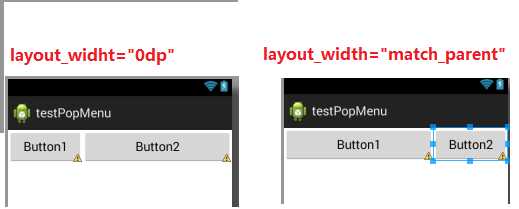标签:
使用weight控制两个按钮在水平方向 1:2
水平方向:layout_width = "0dp"
使用weight属性
<?xml version="1.0" encoding="utf-8"?> <LinearLayout xmlns:android="http://schemas.android.com/apk/res/android" android:layout_width="match_parent" android:layout_height="wrap_content" android:orientation="horizontal" > <Button android:id="@+id/button1" android:layout_width="0dp" android:layout_height="wrap_content" android:layout_weight="1" android:text="Button1" /> <Button android:id="@+id/button2" android:layout_width="0dp" android:layout_weight="2" android:layout_height="wrap_content" android:text="Button2" /> </LinearLayout>
稍作改变:将layout_width = "match_parent"
<?xml version="1.0" encoding="utf-8"?> <LinearLayout xmlns:android="http://schemas.android.com/apk/res/android" android:layout_width="match_parent" android:layout_height="wrap_content" android:orientation="horizontal" > <Button android:id="@+id/button1" android:layout_width="match_parent" android:layout_height="wrap_content" android:layout_weight="1" android:text="Button1" /> <Button android:id="@+id/button2" android:layout_width="match_parent" android:layout_weight="2" android:layout_height="wrap_content" android:text="Button2" /> </LinearLayout>
两者效果对比

只是改变了layout的值, 导致两种显示不同
控件的实际宽度如何计算:
宽度 = 原来宽度 + 剩余宽度的百分比;
通俗来说的是:
宽度 = layout_weight定义的宽度 + (屏幕宽度 - 两个组件layout_weight的宽度)* 百分比
假设屏幕宽度为L
对于layout_width = "0dp"
button1 : = 0dp + (L-0dp-0dp)* 1/3 = 1/3L
button2 : = 0dp + (L - 0dp - 0dp) * 2/3 = 2/3L
layout_width="match_parent"的话 原来宽度为L
button1 = L + (L - (L+L))*1/3 = L - 1/3L = 2/3L
button2 = L + (L -(L+L))*2/3 = L - 2/3L = 1/3L
标签:
原文地址:http://www.cnblogs.com/chengbao/p/5644536.html